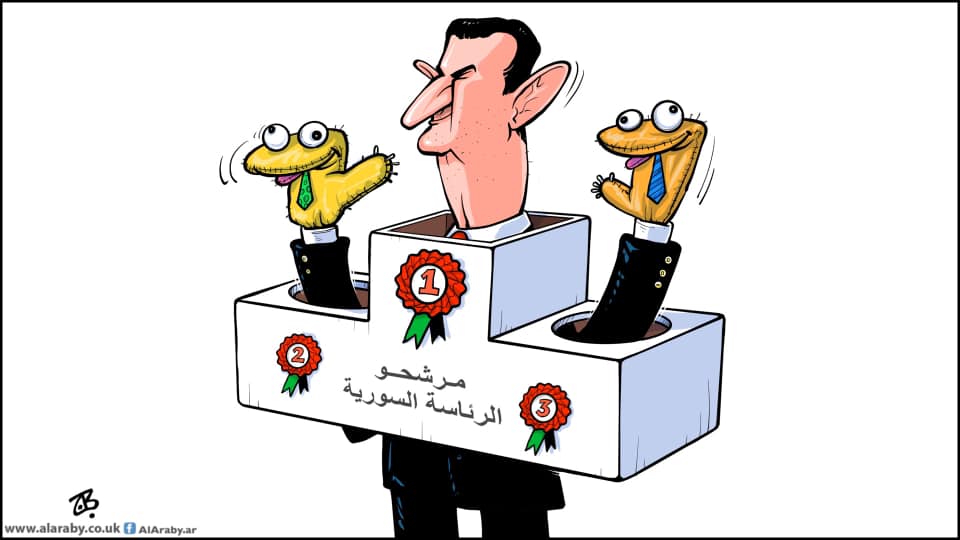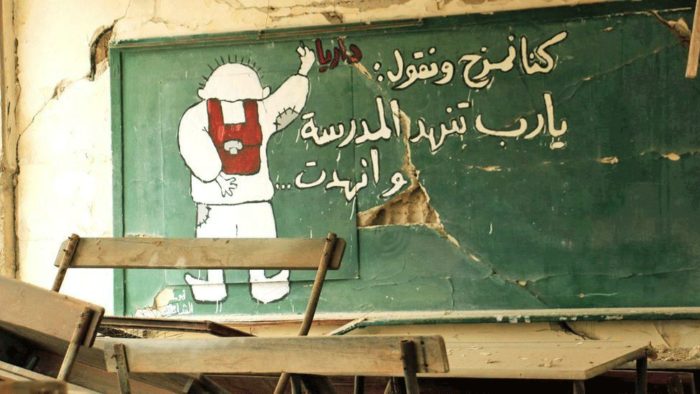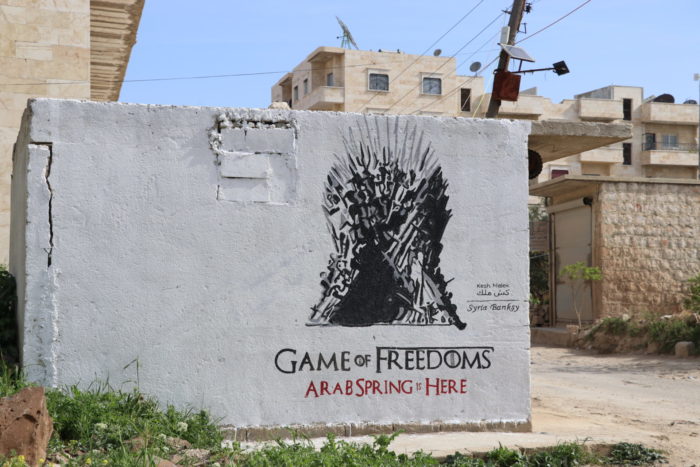Ten Years of Syrian Revolutionary Narratives and Repertoires

In this post, Dr Andrew Delatolla, Lecturer in Middle Eastern Studies at the School of Languages, Cultures and Societies, University of Leeds, reflects on how the transnational revolutionary thrust of the Arab Uprisings continues to play out in Syria, inspiring a cultural resistance that lives on despite the regime's claim of victory.
As populations across North Africa and South West Asia mobilised against their governments in popular protests in 2011, there was much hope for change – particularly as stale regimes began to fall, one by one. Building on the existing revolutionary repertoires and narratives in Tunisia and Egypt, fifteen Syrian youth from prominent families in Daraa, often referred to as the ‘Cradle of the Revolution,’ were arrested, incarcerated, and tortured. Their crime was writing the words ‘your turn, doctor’ (أجاك الدور يا دكتور) on the walls of their school in red spray paint. Whether intending to bring the revolution to Syria or not, the responsible youth had put the revolution in motion. As Keith Baker argues in Scripting Revolution, revolutionary narratives, and even repertoires, can ‘serve as models or counterexamples,’ they act as ‘outlines on which revolutionary actors can improvise’ and can be subsequently transformed by actors as they are inherited (2015, p. 2). These narratives, or schemas for action, and repertoires, or tools and actions used by revolutionaries, function to fulfil goals and gain widespread, often international, attention and support.
Although some have argued that the revolution is effectively over, that Bashar al-Assad has ‘won’ the country, others, including myself, are not so pessimistic. Looking at how narratives and repertoires of revolution have evolved and changed a decade on from 2011, it is evident that a declaration of victory for Assad and his regime is premature. Beginning with the graffiti that was spray painted on the school walls in Daraa, the Syrian revolution has been expressed, as have other revolutionary movements, in chants, slogans, and art. In these expressions, the narratives and repertoires of the Syrian Revolution have continued, making use of new schemas, tools, and actions. In the first days of the revolution, a dabke, a traditional folk dance common to the Levant, was written and performed, going viral on social media. The lyrics called out al-Assad for his lies, crimes, and greed – inviting him to leave through the door. The performance of this Dabke was symbolic, not just for underpinning social solidarity through a recognisable culturally embedded dance, but also its use against a regime that has historically attempted to make claims of Arab Nationalist leadership.
The use of the dabke in the political context is not novel. As a regional folk dance, it has often been co-opted for political and nation building exercises. It has been appropriated by Zionist settlers in Palestine to consolidate and build community;[1] mobilised by Palestinian Nationalists in an effort to undermine and challenge Zionist claims in the region; and it has been used by Arab Nationalists with a Pan-Arab political vision.[2] With the Syrian regime being seen as the leader of the Arab Nationalist cause, following the dethroning of Egypt as a consequence of their peace with Israel in 1979, the use of the dabke to target the legitimacy of the Syrian regime can be viewed, first, as the Syrian regime’s failure in appropriating the folk dance for regional political gain, and, relatedly, the population’s refusal to buy-in to the regime’s Arab Nationalist narrative. Here, the dabke as revolutionary practice was removed from the Syrian regime’s political project, taking back control of the intrinsic symbolism and excluding the Syrian regime from redeveloping the national conscience.
At the time that these revolutionary repertoires were developing and transforming within the Syrian context, being inherited from elsewhere but altered and transformed within their new contexts, the counter-revolutionary practices and failures were also being learned from one regime to another. For instance, al-Assad promised reform in a similar manner to his authoritarian compatriots elsewhere in the Middle East and North Africa; attempting to quell or obstruct revolutionary mobilisation. However, as George Lawson points out, there are some cases where promises of reform seem to hasten revolutions rather than obstruct them.[3]
Similar to President Mubarak in Egypt, al-Assad’s promises of reform were consistently one step behind the demands of the protesters. Yet, learning from the failures of Mubarak’s regime to quell protests, the Syrian regime quickly escalated its crackdown, transforming the civil uprising and revolution into armed conflict; spurned on by regional challenges, including the rise of Da’esh, and foreign assistance from, on the one hand, Russia, Iran, Iraq, and Hezbollah, and on the other hand, the U.S., U.K., France, Turkey, Qatar, and Saudi Arabia. A decade on from the scenes of revolution, Syrians may not have the same opportunities to gather in the streets and express mutual solidarity with each other in their desire to expel the regime. Because of this, opportunities to reclaim ownership of national symbols have dwindled as the revolution was swept up in civil and international conflict. Nevertheless, the revolutionary repertoires have not been broken.

‘We used to joke and say: God please destroy the school … and he did.’ Artwork by Abu Malik Al-Shami
In Syria, Abu Malik al-Shami, transmitted the message of the revolution in street art and murals. His messages incorporated a mixture of dark humour, as well as peace and hope. Al-Shami’s work has been a source of discussion, appearing on the BBC and other news sites. While they do not reflect an environment energised by a political revolution on the streets, they still serve as reminders of the history of the revolution and the consequences of the conflict. In doing so, they continue to subversively target al-Assad, reminding the population in Syria of what has been forcibly lost by the regime in the pursuit of its hold on power. As such, the paintings by Al-Shami are intended for a local audience; they not only provide reminders of but continue a repertoire of dissidence by using art on structures affected by the coercive force of the Syrian regime.

Artwork by Kesh Malek
Others, such as Kesh Malek (Checkmate), an organisation dedicated to fighting for the values promoted during the revolution, have continued to propagate a repertoire of revolution in the production of murals. Located in Idlib, Kesh Malek’s murals, many of them written in English, target a global, and specifically, a Western audience. While they reference the hope of revolution, one mural being ‘Our revolution flower / will bloom one day .. / we will keep trying’, they also reference recognisable cultural products and global affairs. This includes references to the popular TV programme, Game of Thrones, with a mural depicting a throne of guns and the words ‘Game of Freedoms / Arab Spring is Here’. Another mural references the 2019 protests in Sudan with a painting of Alaa Salah, the woman whose image was internationally broadcast as she led revolutionary chants in Khartoum accompanied by the words ‘Liberty is not a statue anymore. She is alive with flesh and blood.’ Playing off of recognisable cultural themes in the West and current affairs hitting the headlines of Western media, the artists behind these murals are providing a schema for how the Syrian revolution has endured; ensuring its continued relevance to greater political discourses.
A decade after people in Syria took to the streets, demanding that al-Assad step down, the narrative of revolution has changed; a result of the unexpected conflict and the subsequent internal displacement of 6.7million people and creation of 6.5million refugees. While the schema of revolution has been forced to change, the sentiment remains. Acting as an archive of the art of the revolution alongside timelines of events, across Syrian geographies, and within the Syrian diaspora, Sana Yazigi’s website ‘Creative Memory of the Syrian Revolution’ documents the changing narratives and repertoires across time and space. Here, the production of the revolutionary narrative and its repertoires do not only exist in historical timelines, as they are constantly being reproduced to reflect on the past and present contexts. Ten years since the revolution began, and although the development of international conflict has altered its course, the repertoires of the Syrian Revolution continue to manifest within new narratives, constantly endangering the stability of the al-Assad regime, despite the proclaimed victory on 20 August, 2017.
In this claim of victory, al-Assad asserted that Syria was now safer and more peaceful because of its contemporary ‘homogeneous society,’ seeking to ensure a permanence to this declaration by continued excessive coercive force; a strategy borrowed from the renewed military regime in Egypt, led by al-Sisi. Yet, as al-Assad and al-Sisi assume the strength of the state, revolutionary sentiment continues to smoulder. The unfinished nature of the revolution in Syria, as in Egypt, continues to produce flashpoints of protest, building on a ten-year archive of narratives and repertoires. This was evident with the renewed protests in Daraa, Damascus, and Rif Dimashq in December 2019 and more recently in June 2020 in as-Suwayda. Here, in a city once loyal to the regime, the continuation of conflict and its consequences, including the shock of the plummeting value of the Syrian pound, compelled people onto the streets, demanding – as those did before them – ‘revolution, freedom, and social justice,’ telling Bashar to leave, and claiming Syria for revolutionaries, not the al-Assad family.
[1] Elke Kaschl, 2003, Dance and Authenticity in Israel and Palestine: Performing the Nation. Boston: Brill, p. 101.
[2] Nicholas Rowe, 2011, Dance and Political Credibility: The Appropriation of Dabkeh by Zionism, Pan-Arabism, and Palestinian Nationalism, in Middle East Journal, 65.3: 363-380.
[3] George Lawson, 2019, Anatomies of Revolution. Cambridge: Cambridge University Press, p. 4.
